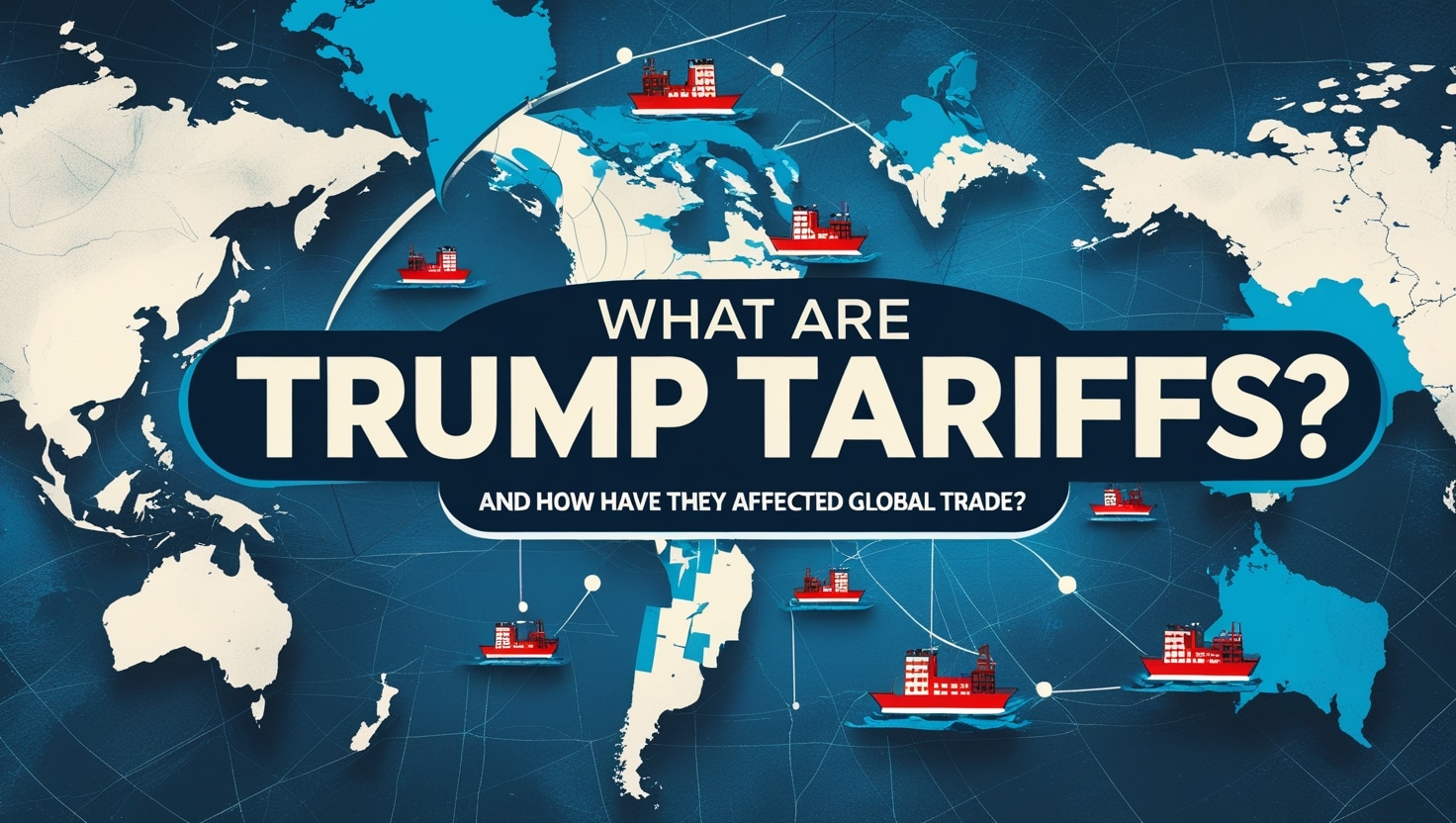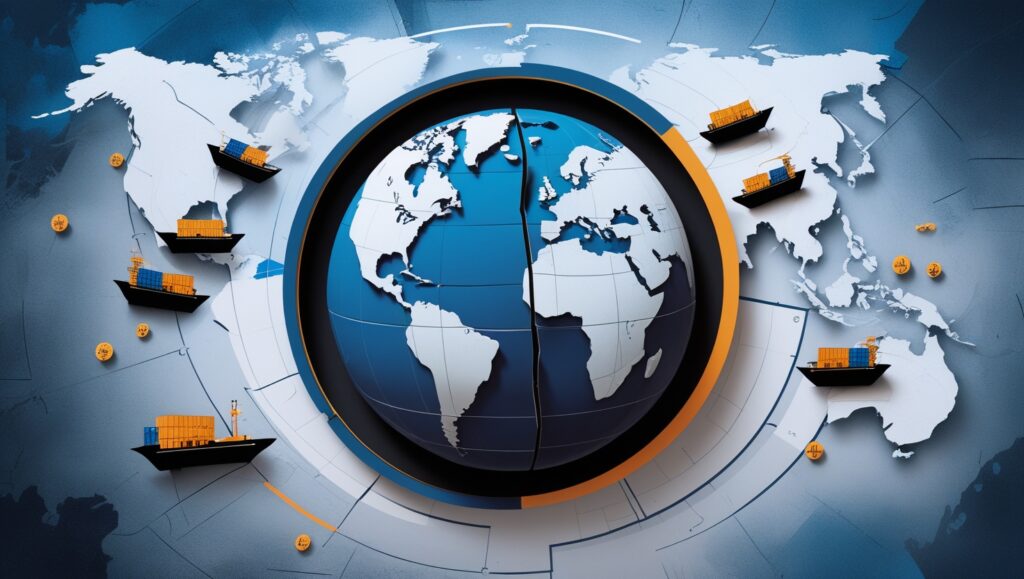
Trump Tariffs refer to a series of import taxes imposed by U.S. President Donald Trump during 2018–2020 as part of his “America First” agenda. These tariffs marked a sharp departure from prior free-trade policies, targeting goods from China and longtime allies alike. Trump argued that tariffs would protect American factories and reduce trade deficits, claiming other countries were “ripping off” the United States. In practice, tariffs act as a tax on imports – costs typically passed on to American importers and consumers, as economists noted. This article explains what the Trump tariffs were, their origins and key implementations, and analyzes how they affected global trade – from economic impacts on China, Canada, and the EU to shifts in industries, expert views, and long-term policy consequences.
Overview: How Trump Tariffs Have Affected Global Trade?
| Category | Key Details | Impact & Results |
|---|---|---|
| Policy Framework |
• Section 232: Steel/Aluminum (25%/10%) • Section 301: China goods (up to 25%) • Covered 15-20% of all U.S. imports by 2019 |
Sharp departure from free-trade policies; Normalized tariffs as policy tool |
| China Trade War |
• $360B in Chinese imports targeted • Phase One deal signed Jan 2020 • Soybean exports fell 53.3% in 2018 |
Supply chain diversification to Vietnam/Mexico; Both economies experienced slowdown |
| Allied Relations |
• Canada: $12.6B retaliation package • EU: €2.8B counter-tariffs on symbolic goods • Mexico: Threatened blanket tariffs averted |
Strained relationships with key allies; USMCA negotiations resolved metal tariffs |
| Sectoral Effects |
• Steel: $900K cost per job saved • Agriculture: $28B in federal aid needed • Auto: Ford lost $1B in profits |
Manufacturing lost 75K jobs net; Farm payments = 1/3 of income by 2019 |
| Economic Analysis |
• Acted as tax on U.S. importers/consumers • Trade deficit remained large • Nobel economists warned of inflation |
GDP growth modestly reduced; Stock market volatility during escalations |
| Long-term Legacy |
• Biden maintained most tariffs • Accelerated “friend-shoring” discussions • WTO role diminished |
Bipartisan shift toward protectionism; More cautious globalization approach |
Origins and Key Implementations of the Trump Tariffs
Origins and Rationale: Trump campaigned on a promise to get tough on trade. He had long criticized trade deals and deficits, vowing to use tariffs to bring back jobs. Shortly after taking office, he withdrew the U.S. from the Trans-Pacific Partnership and demanded a renegotiation of NAFTA (ultimately replaced by USMCA). Trump’s trade strategy centered on applying tariffs unilaterally for leverage.
Legal Basis: The administration invoked old trade laws to justify its actions:
- Section 232 (Trade Expansion Act of 1962) – Allows tariffs on imports deemed threats to national security. Trump used this to slap tariffs on steel and aluminum imports.
- Section 301 (Trade Act of 1974) – Permits tariffs to counter unfair foreign practices. This was used to impose sweeping duties on Chinese goods, citing intellectual property theft.
Major Tariff Actions: Beginning in 2018, several rounds of tariffs rolled out:
| Action | Year | Target | Tariff Rate |
|---|---|---|---|
| Steel & Aluminum Tariffs | 2018 | Global (incl. Canada, EU) | 25% Steel, 10% Aluminum |
| China Tariffs | 2018–2019 | China | Up to 25% |
- Steel & Aluminum Tariffs (March 2018): 25% on foreign steel and 10% on aluminum. Initially exempting Canada, Mexico, and the EU, these duties were soon extended to those allies, sparking global ire.
- China Tariffs (2018–2019): Progressive Section 301 tariffs on approximately $360 billion of Chinese imports, at rates up to 25%, in response to China’s trade practices. China retaliated with its own tariffs on U.S. exports, leading to a heated trade war.
- Other Threats: Trump also threatened tariffs on imported autos (a Section 232 auto investigation) and even on all Mexican goods (to pressure Mexico on immigration). While the auto tariffs did not materialize and the Mexico threat was withdrawn after negotiations, the pattern was clear: tariffs became a go-to tool of U.S. policy under Trump.
By late 2019, the U.S. had tariffs on roughly 15–20% of all its imports, a significant increase from pre-Trump levels. Trading partners answered with commensurate tariffs on U.S. goods. The stage was set for broader economic effects around the world.
Global Economic Impact on Key Trading Partners

Trump’s tariffs – and the retaliation they provoked – reshaped trade with major partners like China, Canada, and the European Union:
China (U.S.–China Trade War)
China (U.S.–China Trade War):
| Sector | 2017 Exports (USD Bn) | 2018 Exports (USD Bn) | Change % |
| Soybeans | 19.5 | 9.1 | -53.3% |
China was the primary target. The U.S. tariffs on Chinese electronics, machinery, and other goods drove up costs for U.S. importers and consumers. Beijing hit back with tariffs on American exports, from soybeans to autos. For example, U.S. agriculture exports to China plunged (soybean sales to China fell by over 50% in 2018). Both economies saw some slowdown, and economists estimate U.S. GDP growth was modestly reduced. The trade war also spurred U.S. companies to seek alternative suppliers in countries like Vietnam and Mexico, though some supply chains began exploring alternatives. In January 2020, a “Phase One” deal paused further escalation – China agreed to buy more U.S. goods and strengthen IP rules, but it did not eliminate the bulk of Trump’s tariffs on China.
Canada and Mexico
Canadian Foreign Minister Chrystia Freeland: “Canada has no choice but to retaliate.”
$12.6 billion tariff package on U.S. goods.
Using Section 232, Trump applied steel and aluminum tariffs on Canada and Mexico in 2018 – a shock to these close U.S. allies. Both countries retaliated. Canada, for instance, imposed tariffs on $12.6 billion of U.S. products including steel, aluminum, whiskey and ketchup. Canadian Foreign Minister Chrystia Freeland said they had “no choice” and would not back down. The dispute pushed Canada and Mexico to the negotiating table: as part of the USMCA trade deal talks, the U.S. lifted the metal tariffs in 2019. Mexico likewise answered with penalties on U.S. exports (targeting farm goods and steel pipes). Trump later threatened blanket tariffs on Mexican imports to force action on illegal migration, but this was averted after a diplomatic compromise. The tariffs strained relations and disrupted North American supply chains (e.g. cross-border auto parts shipments) until tensions eased with the USMCA’s ratification.
European Union and Allies
European Commission President Jean-Claude Juncker: “We will put tariffs on Harley-Davidson, on bourbon, and on blue jeans – Levi’s.”
The EU responded to Trump’s steel/aluminum tariffs with its own retaliatory duties on about €2.8 billion of U.S. goods, aimed at politically symbolic products. European Commission. These counter-tariffs targeted iconic American exports (motorcycles, whiskey, jeans) to pressure U.S. political leaders. Trump also menaced Europe with potential tariffs on European car imports, which unnerved automakers. An analysis found that a blanket car tariff could add $1,800–$5,700 to new car prices and cost hundreds of thousands of auto jobs. While such auto tariffs were not implemented, the threat alone created uncertainty in EU-U.S. trade. Europe also took legal action via the World Trade Organization and sought negotiated solutions. (In 2021, under President Biden, the U.S. and EU reached a truce on steel tariffs, replacing them with a quota system.)
Sectoral Impacts: Steel, Agriculture, and Automotive

Trump’s tariffs had uneven effects across industries. They helped some domestic sectors but hurt others with higher costs and lost markets. Key examples include:
- Steel and Aluminum: U.S. metal producers benefited from import tariffs as prices rose. Domestic steel output and jobs saw a modest uptick in 2018. However, companies using steel faced higher input prices. Economists calculated that American consumers and businesses paid over $900,000 for every steel/aluminum job saved by the tariffs – indicating a very high cost to protect each job. A Federal Reserve study found the metal tariffs actually reduced overall U.S. manufacturing employment by about 75,000 jobs, as job losses in steel-using industries outweighed gains in steel production.
- Agriculture: Farmers were hit hard by retaliatory tariffs. China, the EU, Canada, and others targeted U.S. farm exports like soybeans, corn, pork, and dairy. With China imposing heavy tariffs on U.S. soybeans, American exports of soy to China plummeted (from $19.5 billion in 2017 to $9.1 billion in 2018). Commodity prices fell and farm incomes suffered. The Trump administration had to roll out $28 billion in federal aid to farmers over 2018–2019 to offset losses. By 2019, government payments made up more than one-third of U.S. farm income – a striking sign of the trade war’s toll on rural America.
- Automotive: The auto sector felt a dual impact. Tariffs on steel and aluminum raised manufacturing costs for U.S. cars. Ford Motor Company said the metal tariffs took about $1 billion from its profits due to costlier materials. Other automakers like GM and Honda similarly faced hundreds of millions in increased costs. At the same time, U.S. auto exports (e.g. SUVs and pickup trucks) faced retaliatory tariffs abroad, making them less competitive. Automakers warned that prolonged tariffs would eventually lead to higher car prices for U.S. consumers. The highly integrated nature of auto supply chains meant tariffs risked major disruption. In short, while the tariffs were intended to help U.S. steel and auto workers, they also threatened significant collateral damage to the broader automotive industry.
Expert Commentary and Reactions
Economists and Trade Experts: The vast majority of economists argued Trump’s tariffs would do more harm than good. Joseph Stiglitz, a Nobel-winning economist, warned “virtually all economists” believe the tariffs will be “very bad for America and for the world” and “almost surely be inflationary.” Tariffs raise prices for consumers, effectively acting as a tax, he noted. Even some conservative economists were alarmed: Thomas Sowell cautioned that sweeping tariffs risk replaying the “devastating” trade policies of the 1930s that worsened the Great Depression. He said it was “painful to see… a ruinous decision from the 1920s being repeated,” stressing that a global trade war is a “lose-lose” scenario where “everybody loses”.
Political and Market Response: U.S. businesses that rely on imports (from retailers to manufacturers) mostly opposed the tariffs, citing higher costs and supply chain chaos. Farmers, hit by lost export markets, also grew anxious. Many of Trump’s political allies in farm states pressed for relief. Still, Trump’s protectionist stance resonated with segments of the workforce who felt left behind by globalization – especially steelworkers and others in manufacturing who saw tariffs as leveling the playing field. Financial markets, for their part, reacted nervously. Trade-war headlines frequently sparked stock volatility. (For example, when new China tariffs were unveiled, stock indices dropped amid fears of higher costs and slower growth.)
Trump himself acknowledged the potential short-term pain. President Trump warned Americans of potential economic pain from his new tariffs, framing it as a necessary sacrifice for long-term gain. “We may have short term pain… But long term, the U.S. has been ripped off by virtually every country,” he said, suggesting Americans might need to endure hardship now for a fairer trade future. This rare admission – that his tariffs could hurt consumers initially – was widely reported in Trump tariffs news coverage. It underscored the political gamble: Trump was asking voters to tolerate some economic pain, betting on future wins like revived factories or better trade deals.
Long-Term Consequences and Trade Policy Shifts
In hindsight, the Trump tariffs triggered both immediate disruptions and longer-term shifts in trade policy:
- Short-Term Pain, Mixed Results: The tariffs did bring adversaries to the negotiating table (yielding deals like the USMCA and the Phase One China deal). However, they did not dramatically shrink the U.S. trade deficit or spark a manufacturing renaissance. By 2019, the U.S. trade deficit remained large, and manufacturing activity had cooled, studies estimate the trade war slightly lowered U.S. GDP and cost hundreds of thousands of jobs that might have existed without the tariffs.
- Normalization of Tariffs: One lasting legacy is that higher tariffs became an accepted policy tool. President Biden has left most of Trump’s tariffs in place so far, using them as leverage in dealings with China and others. This suggests a more protectionist tilt in U.S. trade policy may persist, reflecting bipartisan skepticism of unfettered free trade.
- Supply Chain Reorientation: The trade war highlighted risks of overreliance on one country. It accelerated discussions (later amplified by the pandemic) about supply chain diversification and “friend-shoring.” Companies in some industries began seeking to source from countries like Vietnam, India, or Mexico instead of solely China.
- Strained Multilateral System: Trump’s go-it-alone tariff approach sidelined the World Trade Organization’s role. The U.S. imposed tariffs unilaterally instead of through WTO rulings, and trading partners responded in kind. This tit-for-tat undermined faith in the global trading rules. Going forward, nations may be more inclined to pursue bilateral deals or managed trade (specific purchase commitments, quotas, etc.) to settle disputes rather than relying on broad WTO frameworks.
In summary, the Trump tariffs ushered in a more confrontational era of trade relations. They delivered selective benefits to protected industries but at a wide cost to others and sparked retaliation around the world. The episode has redefined trade debate in the U.S., making policymakers more willing to question free trade orthodoxies. At the same time, it served as a cautionary tale: the promised gains from tariffs often came with significant economic side effects.
Conclusion
The Trump tariffs were a bold gambit in global trade policy, aimed at resetting terms in America’s favor. They did elevate pressure on trade partners – leading to new trade agreements and spotlighting issues like China’s tech policies – but they also inflicted pain on many businesses and consumers at home. Allies retaliated, supply chains were upended, and global trade growth slowed amid the uncertainty. As one expert succinctly put it, “escalating trade tensions are a lose-lose situation for all countries involved”.
Ultimately, the tariffs’ long-term impact is a nuanced picture. Some U.S. industries gained from reduced foreign competition, and the political consensus shifted toward tougher stances on trade. Yet many of the tariffs remain in effect to this day, effectively a tax on U.S. importers, while the underlying challenges (such as China’s trade practices or the hollowing-out of certain manufacturing jobs) persist. The Trump tariffs have left a legacy of more cautious globalization – a reminder that in trade wars, there are often no clear winners, only costly compromises.
FAQ
What exactly were the Trump tariffs?
Answer: They were a set of import duties President Donald Trump imposed in 2018–2019 on a wide range of goods. Trump started by adding a 25% tariff on imported steel and 10% on aluminum, claiming it was for national security. Then he hit China with several rounds of tariffs (on electronics, appliances, machinery, etc.) in response to unfair trade practices, sparking a U.S.–China trade war. He also placed tariffs on solar panels, washing machines, and threatened tariffs on autos and Mexican goods. In short, the “Trump tariffs” refer to these protective taxes on imports, aimed at helping U.S. industries but leading to higher costs and retaliatory measures in return.
Why did Trump put tariffs on allies like Canada and the EU?
Answer: Trump used national security as the justification to tariff Canada, Mexico, the EU, and other allies on steel and aluminum. He argued that relying on imported metals could weaken America’s industrial base (for example, in a war or crisis). Allies vehemently disagreed with being labeled a security threat – Canada’s Prime Minister called the claim insulting. The deeper reason was that Trump wanted to protect U.S. metal industries and believed these tariffs would give him leverage to negotiate better trade terms (as seen with the USMCA deal to replace NAFTA). However, hitting allies with tariffs backfired in some ways: they retaliated with their own tariffs on American goods and strained relations, even though some compromises were later reached.
How did the tariffs affect American consumers and jobs?
Answer: American consumers ended up paying more for many products due to the tariffs. When a tariff is placed on an imported item (say, a $1,000 refrigerator from China facing a 25% tariff), U.S. importers either absorb that cost or pass it to shoppers with higher prices. Over the tariff period, consumers saw price increases for goods like appliances, electronics, and even everyday items (one study called the tariffs one of the largest tax hikes in decades). In terms of jobs, the picture was mixed. A few sectors (like U.S. steel mills) added jobs thanks to reduced foreign competition. But other sectors lost jobs – for example, companies that export to China saw orders dry up, and manufacturers using imported parts faced higher costs and sometimes layoffs. Overall, analyses by the U.S. Federal Reserve and others concluded that the tariffs slightly hurt U.S. employment and economic growth on net, once all gains and losses were accounted for.
Did the Trump tariffs achieve their goals?
Answer: Not entirely. Trump’s stated goals were to shrink the U.S. trade deficit, revive manufacturing, and force trading partners to change unfair practices. There were some short-term wins: China did come to the table and signed the Phase One deal (agreeing to buy more U.S. goods, though it ultimately fell short of targets), and NAFTA was revised into the USMCA. However, the overall trade deficit didn’t fall – it actually hit record highs around 2018–2019. Manufacturing saw a brief boost but then slowed, and sectors like farming were severely hurt by retaliatory tariffs. Many economists say the tariffs were too blunt a tool: they inflicted pain but didn’t fundamentally fix the issues of Chinese trade abuses or the decline of certain U.S. industries. In essence, while the tariffs gave the U.S. some bargaining chips and spotlighted trade problems, they only partially achieved their economic goals and came with significant collateral damage.
Are these tariffs still in place now?
Answer: Largely, yes. When President Joe Biden took office (2021), he did not roll back most of Trump’s tariffs. The high tariffs on roughly $350 billion of Chinese imports are still in effect, meaning many goods from China carry extra duties. The steel and aluminum tariffs also remain for most countries, though the U.S. struck deals with some (like the EU) to convert them to quotas rather than tariffs. Essentially, the Biden administration has kept the tariffs as bargaining leverage while it reviews trade strategy. There is ongoing debate in the U.S. about whether to lift some tariffs to ease inflation, but as of now (2025), the core of the Trump tariffs – especially those on China – is still intact and continues to influence prices and trade flows.

















